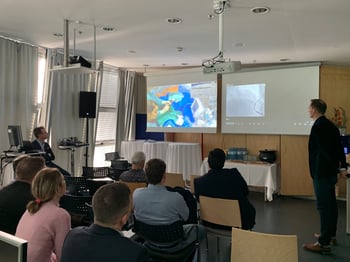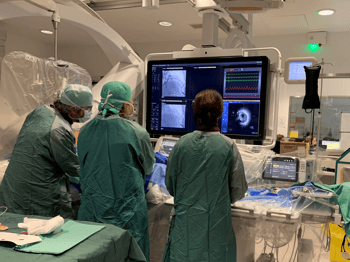Q&A with Dr. Stefan Harb After His IVL Workshop
Recently, Dr. Stefan Harb partnered with Drs. Patrick Siegrist and Tim Schäufele to host the first ever IVL workshop in the DACH region at LKH Graz II Standort West in Graz, Austria. We asked Stefan to relay some of his key takeaways during the workshop and some of the more interesting discussions for the benefit of IVL users across the EU. We hope you enjoy his recap:
- 1. What were some of the most interesting discussion topics during the workshop?
There were lots of interesting discussions during the days’ session. Some of the most engaging topics revolved around whether or not Shockwave will be a replacement for Rotablation. In the end, we decided that it should replace large burrs. This will enable us to do such interventions through 6F sheathless guides, a strategy that comes in quite handy for me as I like to access the distal radial artery for PCI. Rotablation with small burrs will still be needed when you are not able to cross the lesion.
Other topics included appropriate indications for Shockwave, what are the imaging criteria to indicate IVL, not only intracoronary imaging during intervention but also the role of prehospital coronary CT in finding plaque morphology that will require IVL-treatment. And tips and tricks how to get the Shockwave balloon across the lesion safely.

2. Based on the presentations of all the other calcium modification tools currently available to operators, was consensus reached on the role of Shockwave vis-à-vis other technologies?
Yes, this is where the group aligned on an indication:
-
- Rotablation or Laser for uncrossable lesions
- IVL if more than 270° calcified ring on imaging
- IVL instead of risky large rotaburrs
- IVL if high pressure NC- or OPN-balloons had failed to dilate a crossable lesion
3. Were there any challenging live cases performed for the attendees during the meeting in which IVL was put to the test?
 We transmitted several challenging educational live cases from our cath lab, showcasing the ‘Rotatripsy’ approach in uncrossable lesions, the appropriate use of guide extensions, how to judge the effect of IVL on IVUS and OCT and how to differentiate desired longitudinal cracks from unstable spiral dissection that needed an additional stent. We had the audience watch us closely when we did IVL step by step, carefully keeping the pressure at 4 bar while the balloon expanded as we applied the shocks, and stopping in time when one Shockwave balloon lost pressure too quickly while treating extremely rough calcified plaque. All of these cases had been undilatable with high pressure balloon despite trying hard, even going up to 35atm, so they were quite impressive for us and the audience. And most importantly, all of the cases were done successfully and the patients were happy!
We transmitted several challenging educational live cases from our cath lab, showcasing the ‘Rotatripsy’ approach in uncrossable lesions, the appropriate use of guide extensions, how to judge the effect of IVL on IVUS and OCT and how to differentiate desired longitudinal cracks from unstable spiral dissection that needed an additional stent. We had the audience watch us closely when we did IVL step by step, carefully keeping the pressure at 4 bar while the balloon expanded as we applied the shocks, and stopping in time when one Shockwave balloon lost pressure too quickly while treating extremely rough calcified plaque. All of these cases had been undilatable with high pressure balloon despite trying hard, even going up to 35atm, so they were quite impressive for us and the audience. And most importantly, all of the cases were done successfully and the patients were happy!
4. At the end of the course, what were some of your key takeaways?
I think a few key points stand out to me:
2. IVL is indispensable in CHIP-PCI
3. IVL lowers the risk of treatment in calcified lesions
4. IVL should be available in every cath lab
- 5. Were there any unanswered questions that you were left with coming out of the course that require further investigation/clinical data/R&D to address?
Since this is such a new therapy, there are many areas for further exploration; some that were discussed in the meeting include:
- 5. Were there any unanswered questions that you were left with coming out of the course that require further investigation/clinical data/R&D to address?
- How to optimize application of IVL’s energy in long lesions
- How to further develop this method (different balloons shapes to create special effects on different type of plaque, positioning of emitters, more shocks per catheter)
- Further insight into physical basics and new opportunities to leverage Shockwaves (could an emitter be placed in cutting balloon and would it enhance effect of blades at low pressure, etc.)
- Potential benefit and risk of Shockwave in preparing valves for interventional treatment
-
Many thanks for all of the time and energy that Drs. Harb, Siegrist and Schäufele put in to running such a great course. If you would like to run a similar workshop in your region, please do not hesitate to ask your local IVL rep about the possibility.
Important Safety Information - Coronary
Caution: In the United States, Shockwave C2 Coronary IVL catheters are investigational devices, limited by United States law to investigational use. DISRUPT CAD III Study
Shockwave C2 Coronary IVL catheters are commercially available in certain countries outside the U.S. Please contact your local Shockwave representative for specific country availability. The Shockwave C2 Coronary IVL catheters are indicated for lithotripsy-enhanced, low-pressure balloon dilatation of calcified, stenotic de novo coronary arteries prior to stenting. For the full IFU containing important safety information please visit: https://shockwavemedical.com/clinicians/international/coronary/shockwave-c2/


